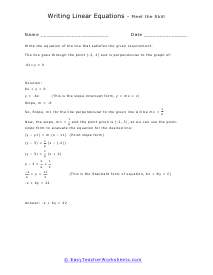How Do You Model Linear Equations? We use models to analyze relationships and make predictions related to those relations. Here, we will learn some useful steps to model linear equations and solve problems. Steps to Model Linear Equations and Solve Problems Usually, we will use the same method while modeling scenarios involve quantities with a constant rate of change. Even, we can use it for any kind of function. Let's review the following steps briefly; First of all, determine the changing quantities and then, represent them by defining descriptive variables. There should not be any mistake. Then, we will draw a picture or define a coordinate system. Understand what actually the problem is to get the vital information. Find useful information that values variables and parts of the functional model like initial value and slope value. Understand the problem and identify what we are trying to determine, interpret, or solve. Find a way to know the finding purpose through the given information. Include tracking units, building a table, or the process of finding a formula for the function you use to model the linear equation. Add a formula for the modeling whenever you need it. Solve the linear equation by using the formula. Justify your answer if it is reasonable for given situation or it mathematically make sense. Write your answer by using correct units and you can write your answers in full sentences.
We are often challenged with unique problems throughout our day. These problems will not only challenge us, but put us in a light to learn more about ourselves. Students will be confronted with a problem that asks them to convert a math sentence to an equation or expression. Often students will need to understand if the variable presented is gaining or losing a portion of the variable. These worksheets explain how to convert given information into linear equations for comparison. Students should already be familiar with the different formulas (slope intercept, for example).













